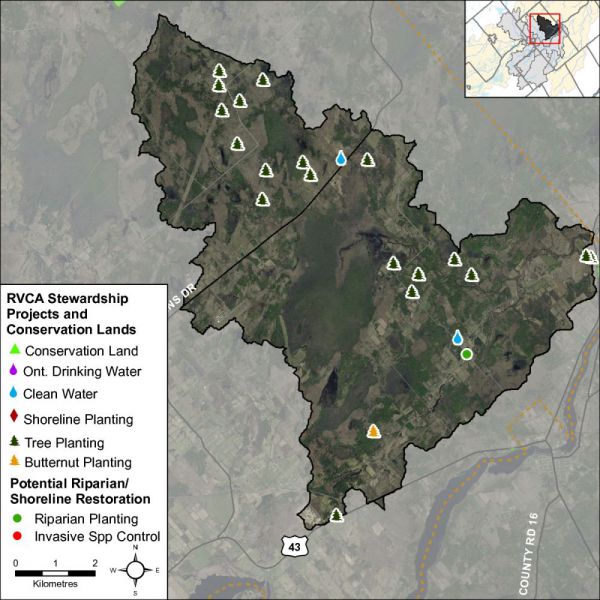5. Stewardship and Protection
The RVCA and its partners are working to protect and enhance environmental conditions in the Middle Rideau Subwatershed. Figure 58 shows the location of all stewardship projects completed in the Rosedale Creek catchment along with sites identified for potential shoreline restoration.
Rural Clean Water Projects
From 2009 to 2014, two septic system replacements, one well decommissioning, one well replacement, one well upgrade and one livestock fencing project were completed. Between 2003 and 2008, two septic system replacements, one well upgrade, one livestock fencing project and one fuel storage and handling facility were constructed along with one septic system replacement and one manure storage facility prior to 2003. Total value of all 13 projects is $99,224 with $45,415 of that amount funded through grant dollars from the RVCA.
Tree Planting Projects
The location of RVCA Tree Planting Program projects is shown in Figure 58. From 2009 to 2014, 13,100 trees were planted at five sites. Between 2003 and 2008, 500 trees were planted at one site and prior to 2003, 62,210 trees were planted at 11 sites, resulting in the reforestation of 40 hectares. Total value of all 17 projects is $222,963 with $65,627 of that amount coming from various fundraising sources.
Valley, Stream, Wetland and Hazard Land Regulation
The Rosedale Creek catchment covers 64 square kilometres with 16.6 square kilometres (or 26 percent) of the drainage area being within the regulation limit of Ontario Regulation 174/06 (Figure 59), giving protection to wetland areas and river or stream valleys that are affected by flooding and erosion hazards.
Wetlands occupy 23.1 sq. km. (or 36 percent) of the catchment. Of these wetlands, 10.5 sq. km (or 45 percent) are designated as provincially significant and included within the RVCA regulation limit. This leaves the remaining 12.6 sq. km (or 55 percent) of wetlands in the catchment outside the regulated area limit.
Of the 90.6 kilometres of stream in the catchment, regulation limit mapping has been plotted along 22.3 kilometers of streams (representing 25 percent of all streams in the catchment). Some of these regulated watercourses (14.8 km or 16 percent of all streams) flow through regulated wetlands; the remaining 7.4 km (or 33 percent) of regulated streams are located outside of those wetlands. Plotting of the regulation limit on the remaining 68.3 km (or 75 percent) of streams requires identification of flood and erosion hazards and valley systems.
Within the regulation limit, “development” and “site alteration” require RVCA permission. The “alteration to waterways” provision of Ontario Regulation 174/06 applies to all watercourses.
Vulnerable Drinking Water Areas
The Rosedale Creek drainage catchment is considered to have a Highly Vulnerable Aquifer. This means that the nature of the overburden (thin soils, fractured bedrock) does not provide a high level of protection for the underlying groundwater making the aquifer more vulnerable to contaminants released on the surface. The Mississippi-Rideau Source Protection Plan includes policies that focus on the protection of groundwater region-wide due to the fact that most of the region, which encompasses the Mississippi and Rideau watersheds, is considered Highly Vulnerable Aquifer. For detailed maps and policies that have been developed to protect drinking water sources, please go to the Mississippi-Rideau Source Protection Region website at www.mrsourcewater.ca to view the Mississippi-Rideau Source Protection Plan.
